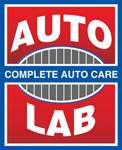
Question: My owner's manual shows that I'm due for a coolant or radiator flush at 90,000 miles. What does coolant do? And do I really need a coolant flush?
Answer: A coolant flush or cooling system flush is modern-day terminology for ridding your radiator of rust, dirt, sludge and old antifreeze or "radiator fluid." The fluid is more accurately known as coolant, which is a 50-50 mix of antifreeze and water.[caption id="attachment_1058" align="alignright" width="300"]

This is what dirty coolant looks like. If your coolant is this color, bring it in to Auto Lab for us to evaluate. Chances are, you’re due for a cooling system flush.[/caption]And yes, flushing the cooling system is an important part of your car's preventive maintenance schedule. Why? Because coolant keeps your engine from overheating—which keeps you from sitting by the side of the tollway waiting for a tow truck.
What Does Coolant Do?
Coolant flows through your radiator, water pump, water hoses and through internal engine passages to keep the engine from overheating. If the coolant level becomes too low, too dirty or too contaminated, it cannot properly cool the engine. The engines in today's vehicles cannot withstand excess heat. If the engine overheats, it can mean catastrophic engine damage and extremely expensive repairs.
What Does "Clean" Coolant Look Like?
Coolant that is still doing its job to protect your engine can be any variety of colors from green to red to orange, but the key is that it will be translucent. When it's past its prime, it will become a brownish color and more opaque. If it's in really bad shape, it will be a sludgy brown.[caption id="attachment_1065" align="alignright" width="300"]

This is what clean coolant looks like. Coolant is a 50-50 mixture of antifreeze and water.[/caption]If coolant is left to deteriorate, it can take its toll on your vehicle's cooling system. Common signs of problems include:
- A low coolant warning light.
- A Check Engine or Service Engine Soon light.
- The engine temperature gauge going to the red zone.
- Low coolant levels.
- Leaking coolant.
- Steam from under the hood.
- Cool or cold air coming from your heating vents (instead of hot air).
A cooling system flush can help prevent these problems.
When Should I Flush My Coolant?
Every carmaker recommends a different schedule for flushing the coolant. While we advise using your owner's manual as a starting point, it's perhaps more important to regularly look at the condition of the coolant.At Auto Lab, we can do that for you, and we can use test strips to ensure the coolant is still able to protect your radiator and other cooling system parts. We’ll also thoroughly check the system’s other components, such as the drive belts, cooling fan, radiator, radiator hoses, water pump and even the radiator cap.
Is a "Drain and Fill" the Same as a Coolant Flush?
No, it is very simply draining the dirty coolant from the radiator and refilling it with clean coolant. This will not remove the dirty fluid that's inside the water hoses, water pump or engine cooling passages. You want to choose an auto repair shop that has a machine to completely remove the dirt and contaminants and aging coolant from the entire cooling system, not just the radiator. Otherwise, you're spending money to only get a fraction of the job done.
How Much Should a Coolant Flush Cost?
The cost of this service varies from shop to shop, depending on the level of service they're providing. We recommend reading our article, "Why does the cost of a coolant flush vary from shop to shop?"



